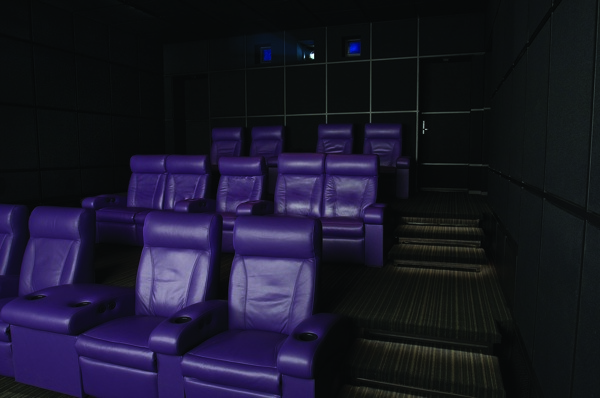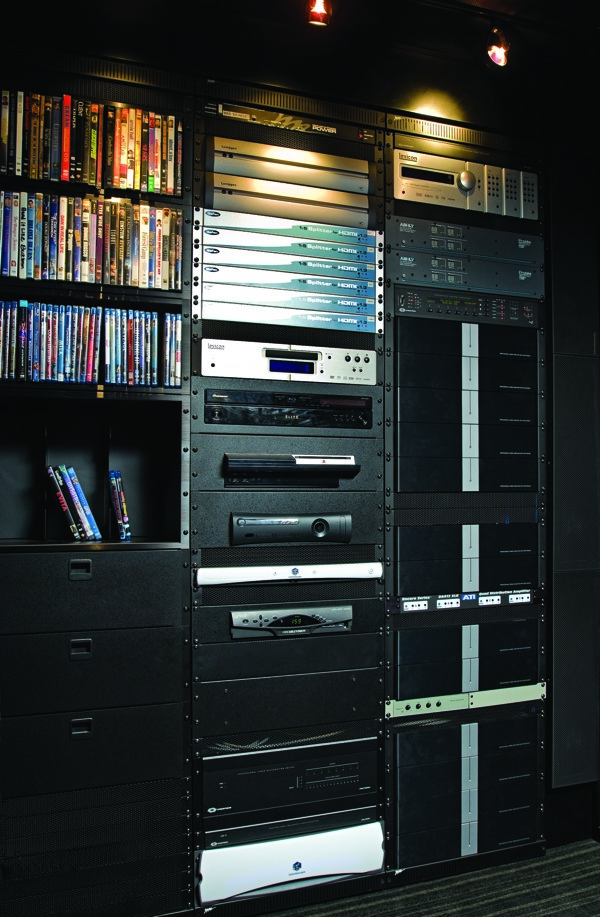Two-Projector Theater

This unconventional subterranean project of a 2000 sq. foot theater actually required two separate projectors. Both from Digital Projection, the integrator installed the 10,000 lumen LIGHTNING Reference 1080p-30 and the 5,700 lumen dVision 30-1080p.
According to David Barson of Opus AVC, "No single projector and lens combination could faithfully reproduce all the resolutions and aspect ratios from 18 video sources. The two projectors ensure that the right amount of resolution and light output is used for the right source material. It also helped save the client money by not lighting up the larger cinema projector for such things as old VHS home movies. [Does anyone really watch VHS in a dedicated theater?-Ed.]
The large home cinema essentially resides inside a perfectly optimized concrete chamber. Purpose-built during the construction of a new addition, the space was constructed by blasting directly into granite, then pouring a six-sided concrete box. Nearly everything in the theater, including the projectors, racks and screen, entered the space by being gradually lowered through a 4' x 4' shaft. Only then could Opus, in conjunction with consultant Tony Grimani of Performance Media Industries, begin the task of creating the most acoustically perfect space possible.

This is also the first residential installation of Tony Grimani's PMI 2.0 screen system. The Screen Research video screen actually has a native aspect ratio of 2.0:1 (150" x 75"), which uses 4-way dynamic masking that can render picture sizes from 80" x 60" for 1.33:1 in standard definition to 150" x 75" for 2.35 on Blu-ray. The video system design ensures maximum image size for all picture formats and maximum flexibility to display different source material at just the right size for each audience member.
Due to the shape of the space, Opus needed projectors that were both capable of intelligent lens movements and a high degree of vertical lens shift. For instance, the LIGHTNING Reference 30 was chosen because it was the only projector that met the needed specifications with respect to intelligent lens memory, brightness, resolution and vertical offset. Moreover, the LIGHTNING Reference is among the most efficient projectors in the industry, offering the highest lumens per watt performance of any projector in its performance class. The index zooming system used in the theater dictates that the screen masking changes the image size, the projector zooms in and out while the screen grows before the audience's very eyes.

A Kaleidescape server directs a Crestron control system to coordinate the correct aspect ratio for the content being displayed. Also. to ensure that the theater performs as efficiently as possible, the entire control system is connected to a clean power supply with its own grounding system. Through a custom power management system, the equipment racks power-down all non-essential equipment automatically after a designated period of inactivity.
With elements such as door triggers and a pre-boot system accessible from outside the theater, this Greenwich theater is a technological marvel on many levels. For example, there are eight sub-woofers totally hidden within recessions in the installed sheetrock. When it's time to leave the theater, the push of a button via a Lutron programming system returns all 13 chairs in the theater to their preset position.
- Log in or register to post comments
























































